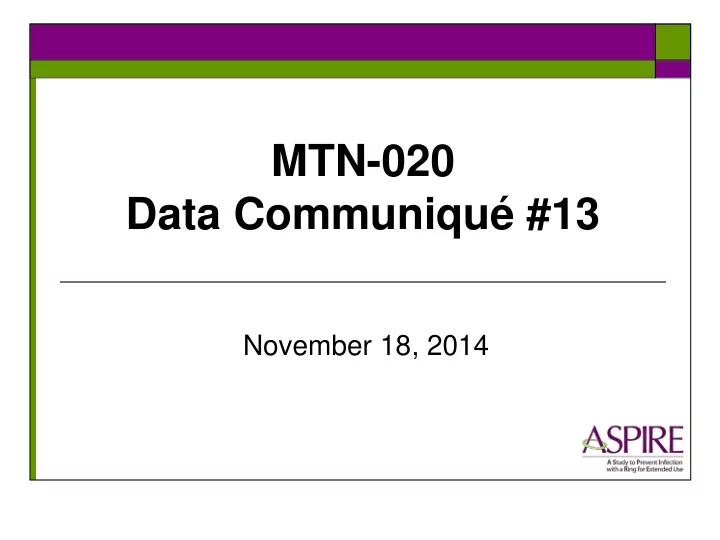

MTN-020 Data Communiqué #13 November 18, 2014
AE Outcome Date when treatment is indicated For AEs requiring treatment, the outcome date should reflect when all associated symptoms have resolved (or returned to baseline severity) or the date when treatment is completed, whichever is later. An AE is not considered resolved until both symptoms and treatment have been completed. Example: A participant presents with Grade 2 vaginal discharge on 23May14 and is prescribed doxycycline. Her symptoms resolve on 27May14 and completes her antibiotic regimen on 06Jun14. The AE outcome date recorded in Item 6 should be 06Jun14 .
Assignment of Severity Grade- Genitourinary infections & symptoms If an AE is graded using the general infection row of the main DAIDS Tox Table and treated with antimicrobial therapy, the infection must be graded automatically at Grade 2 or higher (see SSP section 11.4).
Assignment of Severity Grade- Genitourinary infections & symptoms However, if a genitourinary AE is treated with systemic antimicrobials, the severity grade will depend of whether the FGGT or the main DAIDS Tox Table is used to grade the AE. When grading an AE according to the main DAIDS Tox Table, treatment with systemic antimicrobials warrants a severity grade of 2 or higher. When grading an AE according to the FGGT, treatment with systemic antimicrobials may still be covered under severity grade 1. Grading depends on criteria defined in given row.
Assignment of Severity Grade- Genitourinary infections & symptoms Example #1: A participant presents with mild vaginal discharge and itching and wet mount results are positive for candida. She is given a dose of fluconazole for treatment. This infection should be assigned as Grade 1 per the criteria in the Candida row of the FGGT regardless of whether an antimicrobial was prescribed.
Assignment of Severity Grade- Genitourinary infections & symptoms Example #2: A participant presents with mild nasal congestion, fever, and headache consistent with infective frontal sinusitis and is prescribed Augmentin. This infection should be assigned as at least Grade 2 per the criteria in infection row of the DAIDS General Tox table as systemic antimicrobial treatment was indicated.
Documentation of Missed Menses Events – During Follow up Missed menses AEs that extend >3 months should be documented by updating the completed AE log CRF for ‘missed menses’: Update Item 1 with a new AE term of either: “Oligomenorrhea” for missed menses 4-5 months in duration Or, “Amenorrhea” for missed menses >6 months in duration Update Item 3 with a new severity grade A new AE log CRF should not be completed to document increased duration of the same infrequent bleeding event.
Documentation of Missed Menses Events – During Follow up The updated AE term and severity grade should be assessed per the FGGT row for ‘unexplained infrequent bleeding”. Note: This row excludes missed menses due to hormonal contraception, pregnancy, or post-partum.
Documentation of Missed Menses Events – During Follow up Example: A participant experiences unexplained infrequent bleeding for 2 months and an AE log CRF is completed for Grade 1 ‘missed menses’. She continues to miss her menses for 2 subsequent months. One the same AE log CRF: Item 1 should be updated to “Oligomenorrhea” Item 3 should be updated to a severity grade of “2” If the participant continues to experience missed menses for 6 or more months, in total, the AE log CRF should be updated once again to reflect the new AE term of “amenorrhea” in Item 1.
Cervical Ectopy Assessment Cervical ectopy is a required assessment in ASPIRE, but is considered neither a normal nor abnormal finding. Cervical ectopy assessment is required in Item 3 on the Pelvic Exam CRF. However, the ‘no normal variants or abnormal findings’ box on the Pelvic Exam Diagrams non-DataFax form may be marked if only ectopy is observed. The presence of cervical ectopy is common and should not factored into questions on the diagram form.
CRF Tracking System (CTS) Reminder CTS provides two types of emailed reports to track the number of CRFs received and validated at SCHARP: Reception Report: Validation Report: List of transmissions List of Study number, received from a site PTID, Fax ID page and includes date/time number, CRF plate of transmission, # number, visit code, and pages received, unique validation date for each “Fax Raster” ID” CRF received and validated at SCHARP To manage the frequency of these reports and the staff who should receive these reports, email support@scharp.org to complete a CRF Tracking System Registration Form.
Questions? Please contact Jen Berthiaume and Karen Patterson with any questions you have about this slide presentation or the Data Communiqué. Email us at: jberthia@scharp.org karenp@scharp.org
Recommend
More recommend